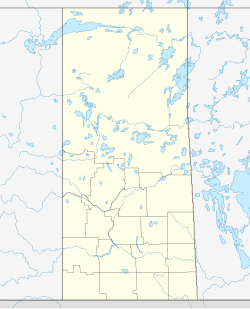Top Qs
Timeline
Chat
Perspective
Warman, Saskatchewan
City in Saskatchewan, Canada From Wikipedia, the free encyclopedia
Remove ads
Warman (/ˈwɔrmən/) is the ninth-largest city in the Canadian province of Saskatchewan. It is located approximately 20 kilometres (12 mi) north of the city of Saskatoon, and 5 kilometres (3.1 mi) northeast of the city of Martensville. According to the 2021 census, Warman is the fastest growing municipality in Saskatchewan,[4] and was the fastest growing municipality in Canada between 2011 and 2016.[5] Warman is a bedroom community of Saskatoon. The current mayor is Gary Philipchuk.
Warman is the newest city in Saskatchewan, officially incorporated on October 27, 2012.[6] Warman is surrounded by the Rural Municipality of Corman Park No. 344.
Remove ads
History
Summarize
Perspective


Warman was first established in the fall of 1904 when the Canadian Northern Railway built its northern line (running from Humboldt to North Battleford) at the intersection with the Canadian Pacific Railway north–south line (running from Regina to Prince Albert). The original railway station was opened in the spring of 1907,[7] and currently holds heritage status. Operational until 1942, the building now serves as a senior citizens' drop-in centre.[8]
Informally called "Diamond" due to the diamond shape made by the intersecting railway tracks, the name of the settlement was soon changed to Warman, in honour of Cy Warman (from Illinois), a journalist, author, and poet who worked as a publicity writer for Canadian Northern and the Grand Trunk Pacific Railway documenting the railway expansion boom in western Canada.[9]
Following the completion of the new railway, there was an inflow of settlers into the region, drawn by the promise of a quarter section of farmland for $10 as well as by the economic opportunities in the new community. The government, newspapers, and railways all promoted settlement, and Warman quickly developed into a thriving community with a school, churches, a bank, two hotels, a newspaper, a blacksmith shop, a shoe repair shop, many general stores and wooden pavements.[10]
A fire in 1908, followed by a tornado in 1910, destroyed most of the newly created village, including most of Main Street, reducing the population. Main Street became a residential side street, as the residents opted to rebuild along Central Street instead. The population continued to decline in the aftermath of World War I and by 1927, the village had dropped to unincorporated hamlet status, having its administrative affairs handled by the Rural Municipality of Warman.[10]
In the early 1950s Warman began to grow again, as one of the first bedroom communities of Saskatoon. By 1961, the population of Warman had reached 659, so it was decided in 1962 to reincorporate as a village, then as a town four years later. By 2011, the town grew to a population of 7,084. The town council applied for city status in 2012, which was approved by the provincial government in the summer of that year. Warman officially became a city on October 27, 2012.[6]
Remove ads
Demographics
In the 2021 Census of Population conducted by Statistics Canada, Warman had a population of 12,419 living in 4,162 of its 4,313 total private dwellings, a change of 12.7% from its 2016 population of 11,020. With a land area of 13.1 km2 (5.1 sq mi), it had a population density of 948.0/km2 (2,455.3/sq mi) in 2021.[11]
Ethnicity
Remove ads
Education
Prairie Spirit School Division provides public education in Warman, and operates four[19] schools in the city:
- Warman Elementary School
- Traditions Elementary School
- Warman Community Middle School
- Warman High School
Greater Saskatoon Catholic Schools operates one school in the city:[20]
- Holy Trinity Catholic School[21]
Great Plains College, offering post-secondary education, has one campus in the city.[19]
Media
Due to its proximity to Saskatoon, Warman receives radio and television broadcasts from the city. Warman has a local newspaper, the Clark's Crossing Gazette, which also serves Martensville and other surrounding areas.
Infrastructure
Transportation
Warman is situation on the Louis Riel Trail (Highway 11), which links Saskatoon to Prince Albert. Highways 305 and 784 provide access to Martensville to the west. The closest major airport is the Saskatoon John G. Diefenbaker International Airport.
Notable people
Ed Dyck, former NHL hockey player, was born in Warman.
See also
References
Further reading
External links
Wikiwand - on
Seamless Wikipedia browsing. On steroids.
Remove ads




